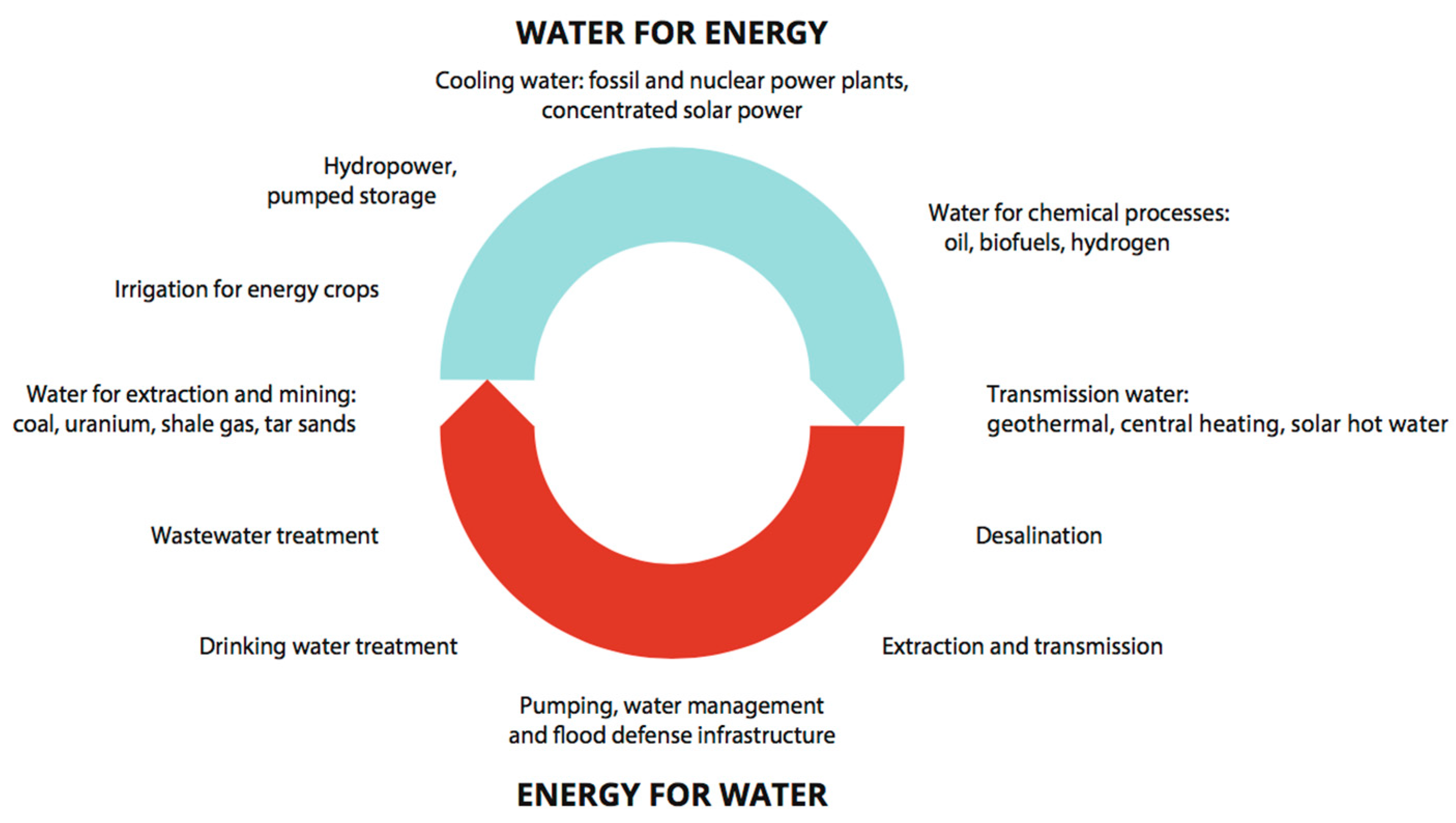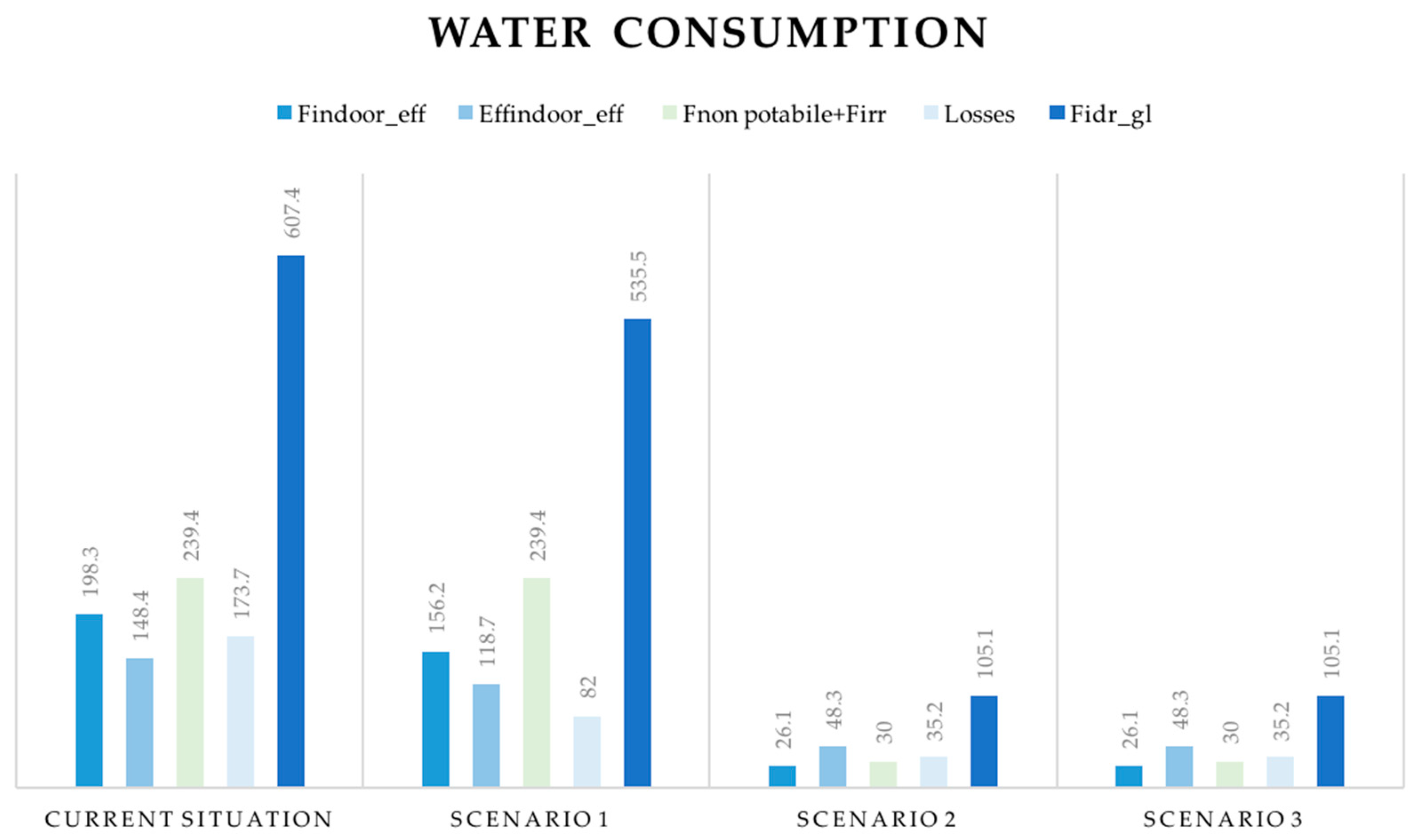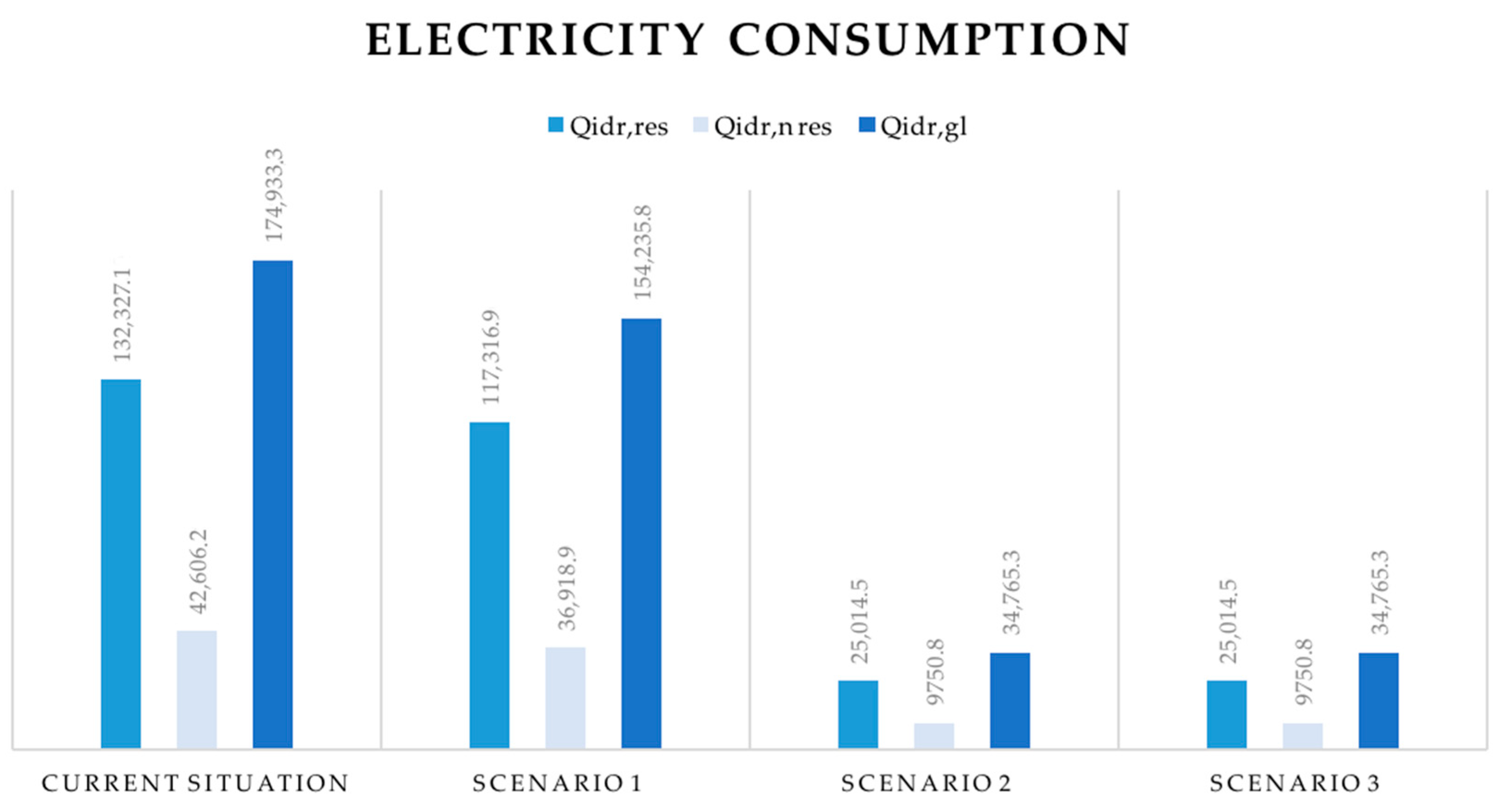Reducing CO2 Emissions and Improving Water Resource Circularity by Optimizing Energy Efficiency in Buildings
Abstract
:1. Introduction
The Role of Water Resource Circularity in Achieving the Decarbonization Goal
2. Strategies and Research Methodology
- Water saving and improvement of the water resource circularity process through sustainable management and the “responsible behavior” of users;
- Optimization of the energy efficiency of systems serving the integrated water cycle in buildings and urban districts;
- Reduction in CO2 emissions linked to the integrated water cycle through technological and engineering solutions in buildings and urban districts.
2.1. Water Saving and Improvement of the Water Resource Circularity Process through Sustainable Management and the “Responsible Behavior” of Users
2.2. Optimization of the Energy Efficiency of Systems Serving the Integrated Water Cycle in Buildings
2.3. Reduction in CO2 Emissions Linked to the Integrated Water Cycle through Technological and Engineering Solutions in Buildings
2.4. Research Method: Calculation of Water Consumption, Energy Consumption Linked to Water Needs, and CO2 Emissions
2.4.1. Calculation Method Adopted for the Water Requirements of Buildings
- Amount of drinkable water for indoor use in residential buildings;
- Amount of drinkable water for indoor use in non-residential buildings;
- Amount of wastewater sent to the district sewage system;
- Amount of rainwater captured and stored;
- Amount of water needed to irrigate green areas;
- Quantity of water losses from the water grid.
- 7.
- Overall water requirement in buildings;
- 8.
- Amount of electricity to cover the water needs of the buildings.
- 9.
- Amount of CO2 emissions related to water needs of the urban district;
- 10.
- Amount of CO2 emissions related to the production of electricity to cover the water needs of the urban districts.
2.4.2. Calculation of the Overall Water Requirements in Buildings
2.4.3. Calculation of the Amount of Electricity to Cover the Water Needs of Buildings
2.4.4. Calculation Method of the Amount of CO2 Emitted by the Integrated Water Cycle during the Use and Distribution Phase
2.4.5. Calculation of CO2 Emissions Related to the Production of Electricity Necessary to Cover the Water Needs
2.5. Optimization of the Energy Use Related to Water Consumption in Buildings: Three Renovation Scenarios
2.5.1. Scenario 1: Light Energy Zero-Emission Renovation
2.5.2. Scenario 2: Medium Energy Zero-Emission Renovation
2.5.3. Scenario 3: Deep Energy Zero-Emission Renovation
3. Results and Discussion
4. Conclusions
Author Contributions
Funding
Institutional Review Board Statement
Informed Consent Statement
Data Availability Statement
Conflicts of Interest
References
- Millennium Ecosystem Assessment. Ecosystems and Human Well-Being: Synthesis; Island Press: Washington, DC, USA, 2005; ISBN 1-59726-040-1. [Google Scholar]
- WWF Italia. L’impronta Idrica Dell’italia; Ufficio Editoria WWF Italia: Roma, Italy, 2014. [Google Scholar]
- IPCC. 2022: Water. In Climate Change 2022: Impacts, Adaptation and Vulnerability; Contribution of Working Group II to the Sixth Assessment Report; Cambridge University Press: Cambridge, UK; New York, NY, USA, 2022; pp. 551–712. [Google Scholar]
- Ligtvoet, W.; PBL Netherlands Environmental Assessment Agency; IHE Delft; Clingendeal; Blue Land. The Geography of Future Water Challenges: PBL Netherlands. 2018. Available online: https://www.pbl.nl/sites/default/files/downloads/pbl-2018-the-geography-of-future-water-challenges-2920_2.pdf (accessed on 25 May 2022).
- UN-Water. United Nations World Water Development Report 2020: Water and Climate Change; UNESCO: Paris, France, 2020; ISBN 978-92-3-100371-4. [Google Scholar]
- IPCC. 2022: Cities, Settlements and Key Infrastructure. In Climate Change 2022: Impacts, Adaptation and Vulnerability; Contribution of Working Group II to the Sixth Assessment Report of the Intergovernmental Panel on Climate Change; Cambridge University Press: Cambridge, UK; New York, NY, USA, 2022; pp. 907–1040. [Google Scholar]
- WE, EU Water Alliance—Opportunity and Necessity for Europe to Build a Water-Smart Society and Circular Economy, Bruxelles. Available online: https://watereurope.eu/eu-water-alliance-launches-its-manifesto/ (accessed on 25 May 2022).
- GUCE, Direttiva 98/83/CE del Consiglio del 3 novembre 1998 concernente la qualità delle acque destinate al consumo umano—L. 330/32 del 5.12.98 e successivamente modificata da Regolamento (CE) n 1882/2003 del Parlamento Europeo e del Consiglio del 29 settembre 2003 (L.284 del 31.10.2002), Regolamento (CE) n 596/2009 del Parlamento Europeo e del Consiglio del 18 giugno 2009 (L. 188 del 18.7.2009) e Direttiva (UE) 2015/1787 della Commissione del 6 ottobre 2015 (L. 260 del 7.10.2015), Italia. 1998. Available online: https://eur-lex.europa.eu/legal-content/IT/TXT/PDF/?uri=CELEX:31998L0083 (accessed on 25 May 2022).
- WAREG. Five Year Report 2014–2019; WAREG Secretariat: Milan, Italy, 2019. [Google Scholar]
- WWC. Start with Water—Putting Water on Local Action Agendas to Support Global Change; World Water Council: Marseille, France, 2018. [Google Scholar]
- EC. Commission Staff Working Document—Evaluation of the Council Directive 91/271/CEE of 21 May 1991, Concerning Urban Waste-Water Treatment—SWD (2019) 700 Final; European Commission: Bruxelles, Belgium, 2022. [Google Scholar]
- WE. For a Green, Circular & Smart Urban Wastewater Treatment Directive; Water Europe: Bruxelles, Belgium, 2021. [Google Scholar]
- ARUP. How the Water Sector Can Embrace Net Zero, London. Available online: https://www.arup.com/perspectives/clear-thinking-how-the-water-sector-can-embrace-net-zero (accessed on 25 May 2022).
- ARUP. The Rockfeller Foundation and the Resilience Shift, The City Water Resilience Approach; Arup Group: London, UK, 2019; Available online: https://www.resilienceshift.org/wp-content/uploads/2019/04/CWRA_City_Water_Resilience_Approach.pdf (accessed on 25 May 2022).
- ARUP. The Rockfeller Foundation and the Resilience Shift, The City Water Resilience Approach—Water Resilience Literature Review; Arup Group: London, UK, 2019; Available online: https://www.resilienceshift.org/wp-content/uploads/2019/04/CWRA_Literature-Review.pdf (accessed on 25 May 2022).
- Pouyfaucon, A.B.; García-Rodríguez, L. Solar thermal-powered desalination: A viable solution for a potential market. Desalination 2020, 435, 60–69. [Google Scholar] [CrossRef]
- Wilder, M.O.; Aguilar-Barajas, I.; Pineda-Pablos, N.; Varady, R.G.; Megdal, S.B.; McEvoy, J.; Merideth, R.; Zúñiga-Terán, A.A.; Scott, C.A. Desalination and water security in the US–Mexico border region: Assessing the social, environmental and political impacts. Water Int. 2016, 41, 756–775. [Google Scholar] [CrossRef]
- WEF. Circular Cities: A Circular Water Economy for Cleaner, Greener, Healthier, More Prosperous Cities—The Imagine If Water Series. Briefing Paper. Geneve/Cologny. Available online: https://www3.weforum.org/docs/WEF_Imagine_IF_Water-Series_2021.pdf (accessed on 25 May 2022).
- The Circonomist & NextGen EU, Circular Economy Trailblazers Reveal Path Towards Sustainable Water Use and New Markets. Available online: https://nextgenwater.eu/circular-economy-trailblazers-reveal-path-towards-sustainable-water-use-and-new-market (accessed on 25 May 2022).
- Smol, M.; Adam, C.; Preisner, M. Circular economy model framework in the European water and wastewater sector. J. Mater. Cycles Waste Manag. 2020, 22, 682–697. [Google Scholar] [CrossRef]
- Kehrein, P.; Van Loosdrecht, M.; Osseweijer, P.; Garfí, M.; Dewulf, J.; Posada, J. A critical review of resource recovery from municipal wastewater treatment plants—market supply potentials, technologies and bottlenecks. Environ. Sci. Water Res. Technol. 2020, 6, 877–910. [Google Scholar] [CrossRef]
- EEA. Beyond Water Quality—Sewage Treatment in a Circular Economy; EEA Report n. 05/2022; European Environment Agency: Copenhagen, Denmark, 2022; ISBN 978-92-9480-478-5. [Google Scholar]
- Płuciennik-Koropczuk, E.; Myszograj, S.; Mąkowski, M. Reducing CO2 Emissions from Wastewater Treatment Plants by Utilising Renewable Energy Sources—Case Study. Energies 2022, 15, 8446. [Google Scholar] [CrossRef]
- IEA. World Energy Outlook 2018, International Energy Agency, Paris. Available online: https://www.iea.org/weo2018/ (accessed on 25 May 2022).
- Mirhosseini, M.; Heydari, A.; Astiaso Garcia, D.; Mancini, F.; Keynia, F. Reliability based maintenance programming by a new index for electrical distribution system components ranking. Optim. Eng. 2022, 23, 2315–2333. [Google Scholar] [CrossRef]
- EEA. Adaptation Challenges and Opportunities for the European Energy System—Building a Climate Resilient Low-Carbon Energy System; EEA Report n. 01/2019; European Environment Agency: Copenhagen, Denmark, 2019; ISBN 978-92-9480-065-7. [Google Scholar]
- Eurostat, Population and Population Change Statistics. Luxemburg. Available online: http://ec.europa.eu/eurostat/statisticsexplained/index.php/Population_and_population_change_statistics#EU-28_population_continues_to_grow (accessed on 25 May 2022).
- Fricko, O.; Parkinson, S.C.; Johnson, N.; Strubegger, M.; van Vliet, M.T.; Riahi, K. Energy sector water use implications of a 2 °C climate policy. Environ. Res. Lett. 2016, 11, 034011. [Google Scholar] [CrossRef]
- McMahon, J.E.; Price, S.K. Water and Energy Interactions, Lawrence Berkley National Laboratory, Berkeley, CA. Available online: https://escholarship.org/content/qt5pr6r5h6/qt5pr6r5h6.pdf?t=mqv33o (accessed on 25 May 2022).
- Scott, C.A.M.; Kurian, J.L.; Wescoat, J.L., Jr. The water-energy-food nexus: Adaptive capacity to complex global challenges. In Governing the Nexus: Water, Soil and Waste Resources Considering Global Change; Kurian, M., Ardakanian, R., Eds.; Springer: Berlin, Germany, 2015. [Google Scholar]
- Pittock, J.; Hussey, K.; Dovers, S. Climate, Energy, and Water: Managing Trade—Offs, Seizing Opportunities; Cambridge University Press: Cambridge, UK, 2015. [Google Scholar]
- Berrill, P.; Arvesen, A.; Scholz, Y.; Gils, H.C.; Hertwich, E.G. Environmental impacts of high penetration renewable energy scenarios for Europe. Environ. Res. Lett. 2016, 11, 014012. [Google Scholar] [CrossRef]
- IRENA, Renewable Energy in the Water, Energy & Food Nexus, Abu Dhabi, UAE. Available online: http://www.irena.org/-/media/Files/IRENA/Agency/Publication/2015/IRENA_Water_Energy_Food_Nexus_2015.pdf (accessed on 25 May 2022).
- Ghimire, S.R.; Barkdoll, B.D. Issues in Energy Consumption by Municipal Drinking Water Distribution Systems. Restoring Our Natural Habitat. In Proceedings of the 2007 World Environmental and Water Resources Congress, Tampa, FL, USA, 15–19 May 2007; pp. 1–10. [Google Scholar]
- Global Water Intelligence e Water without Carbon (2022), Mapping Water’s Carbon Footprint—Our Net Zero Future Hinges on Wastewater, Media Analytics Ltd., Oxford. Available online: https://www.globalwaterintel.com/water-without-carbon (accessed on 25 May 2022).
- Liu, F.; Tait, S.; Schellart, A.; Mayfield, M.; Boxall, J. Reducing carbon emissions by integrating urban water systems and renewable energy sources at a community scale. Renew. Sustain. Energy Rev. 2020, 123, 109767. [Google Scholar] [CrossRef]
- WE. Water Europe Contributions to the European Green Deal and Horizon Europe—Water Europe Vision Implementation 2020–2027 and Annexes; Water Europe: Bruxelles, Belgium, 2020. [Google Scholar]
- REF Ricerche. Soluzioni Basate Sulla Natura Nel Servizio Idrico: La Risposta Ad Un Clima Che Cambia. Laboratorio SPL Collana Ambiente, Acqua n°228 Dicembre 2022; REF Ricerche: Milano, Italy, 2022. [Google Scholar]
- Conte, G. Nuvole e Sciacquoni—Come Usare Meglio L’acqua in Casa e in Città; Edizioni Ambiente srl: Milano, Italy, 2008. [Google Scholar]
- Woods Ballard, B.; Wilson, S.; Udale-Clarke, H.; Illman, S.; Scott, T.; Ashley, R.; Kellagher, R. The SuDS Manual, C753; CIRIA: London, UK, 2015; ISBN 978-0-86017-760-9. [Google Scholar]
- Masi, F.; Rizzo, A.; Bresciani, R. Sustainable Rainwater Management in the City: Opportunities and Solutions for the Anthropic Environmental Impacts Reduction and Urban Resilience Increas. In Smart Metropolia—Przestrzenie Relacji; Dlugi Targ 39/40, 80-830; Obszar Metropolitalny Gdansk-Gdynia-Sopot ul.: Gdansk, Poland, 2018. [Google Scholar]
- Nastasi, B.; Manfren, M.; Groppi, D.; Lamagna, M.; Mancini, F.; Astiaso Garcia, D. Data-driven load profile modelling for advanced measurement and verification (M&V) in a fully electrified building. Build. Environ. 2022, 221, 109279. [Google Scholar]
- Garofalo, E.; Mancusi, L.; Morandi, S.; Volonterio, M. Energia ed Efficienza Energetica Del Servizio Idrico Integrato. Area “Efficienza Energetica E Risparmio Di Energia Negli Usi Finali Elettrici Ed Interazione Con Altri Vettori Energetici”; Ricerca Sistema Energetico (RSE): Milano, Italy, 2017. [Google Scholar]
- REF Ricerche. Climate-Smart Water Utilities: La Roadmap per la Decarbonizzazione del Settore Idrico, Laboratorio SPL Collana Ambiente LabTech N°212 Maggio 2022; REF ricerche: Milano, Italy, 2022; ISSN 2531-3215. [Google Scholar]
- Demir, Ö.; Yapıcıoğlu, P. Investigation of GHG emission sources and reducing GHG emissions in a municipal wastewater treatment plant, in GHG Greenh. Gases Sci. Technol. 2019, 9, 948–964. [Google Scholar]
- IPCC. IPCC Special Report Global Warming of 1.5 °C; IPCC: Bern, Switzerland, 2018. [Google Scholar]
- ITACA, Protocollo Itaca Lazio 2015, Destinazione d’uso Residenziale. Available online: https://www.regione.lazio.it/sites/default/files/2021-04/Protocollo_Itaca_Residenziale_2015.pdf (accessed on 25 May 2022).
- ITACA, Protocollo Itaca Lazio 2015, Destinazione d’uso non Residenziale. Available online: https://www.regione.lazio.it/sites/default/files/2021-04/Protocollo_Itaca_Non_Residenziale_2015.pdf (accessed on 25 May 2022).
- Becciu, G.; Paoletti, A. Fondamenti di Costruzioni Idrauliche; Utet Scienze tecniche: Milano, Italy, 2010; ISBN 10 8859805228. [Google Scholar]
- EA. Greenhouse Gas Emissions of Water Supply and Demand Management Options. Science Report—SC070010; Environment Agency: Bristol, UK, 2008; ISBN 978-1-84432-921-2. [Google Scholar]
- EurEau, Europe’s Water in Figures. An Overview of the European Drinking Water and Waste Water Sectors—2021 Edition. Available online: https://www.eureau.org/resources/publications/eureau-publications/5824-europe-s-water-in-figures-2021/file (accessed on 25 May 2022).
- ISTAT, Censimento Delle Acque Per Uso Civile. Available online: https://www.istat.it/it/archivio/279363 (accessed on 25 May 2022).
- ISTAT, Le Statistiche Dell’istat Sull’acqua—Anni 2019–2021. Available online: https://www.istat.it/it/archivio/268242 (accessed on 25 May 2022).
- MITE, Dipartimento Energia—Direzione Generale Infrastrutture E Sicurezza—La situazione energetica nazionale nel 2021, Roma. Available online: https://dgsaie.mise.gov.it/pub/sen/relazioni/relazione_annuale_situazione_energetica_nazionale_dati_2021.pdf (accessed on 25 May 2022).
- REN21. Renewables 2022 Global Status Report. REN21 Secretariat c/o UN Environment Programme; REN21: Paris, France, 2022; ISBN 978-3-948393-04-5. [Google Scholar]




| Country | Electricity Consumption [Million kWh/y] | Water Consumption [Million m3/y] | k4 [kWh/m3] |
|---|---|---|---|
| Austria | 190 | 577 | 0.329 |
| Belgium | 658 | 738 | 0.891 |
| Denmark | 144 | 360 | 0.400 |
| Finland | 257 | 322 | 0.797 |
| Ireland | 178 | 329 | 0.541 |
| Italy | 7500 | 26,000 | 0.288 |
| Netherlands | 456 | 1140 | 0.400 |
| Portugal | 531 | 572 | 0.929 |
| Spain | 1218 | 3107 | 0.392 |
| Sweden | 473 | 675 | 0.700 |
| Switzerland | 351 | 761 | 0.461 |
| Hungary | 256 | 454 | 0.563 |
| Intended Use | Buildings | Inhabitants | Surface [m2] | Volume [m3] | |
|---|---|---|---|---|---|
| Residential | 30 | 3680 | 54,528 | 163,584 | |
| Non-residential | Office | 1 | 6530 | 6530 | 19,590 |
| Commercial | 2 | 1053 | 7376 | 22,128 | |
| Receptive | 1 | 276 | 6072 | 18,216 | |
| Educational | 3 | 1368 | 10,940 | 32,820 | |
| Restaurants | 1 | 295 | 1196 | 3588 | |
| Total | 38 | 7326 | 86,642 | 259,926 | |
| Water Consumption [m3/y] | Findoor_eff | Effindoor_eff | Fnon pot + Firr | Losses | Fidr_gl |
|---|---|---|---|---|---|
| Current situation | 198.3 | 148.4 | 239.4 | 173.7 | 607.4 |
| Scenario 1 | 156.2 | 118.7 | 239.4 | 82.0 | 535.5 |
| Scenario 2 | 26.3 | 48.3 | 30 | 35.2 | 105.1 |
| Scenario 3 | 26.3 | 48.3 | 30 | 35.2 | 105.1 |
| Electricity Consumption [kWh/y] | Qidr,res | Qidr,n res | Qidr,gl |
|---|---|---|---|
| Current situation | 132,327 | 42,606 | 174,933 |
| Scenario 1 | 117,317 | 36,919 | 154,236 |
| Scenario 2 | 25,015 | 9751 | 34,765 |
| Scenario 3 | 25,015 | 9751 | 34,765 |
| CO2 Emissions [kgCO2eq*m3/y] | CO2_idr,res | CO2_idr,n res | CO2_idr,gl |
|---|---|---|---|
| Current situation | 693.4 | 223.3 | 916.7 |
| Scenario 1 | 614.5 | 193.5 | 808 |
| Scenario 2 | 114 | 44.4 | 158.4 |
| Scenario 3 | 0 | 0 | 0 |
Disclaimer/Publisher’s Note: The statements, opinions and data contained in all publications are solely those of the individual author(s) and contributor(s) and not of MDPI and/or the editor(s). MDPI and/or the editor(s) disclaim responsibility for any injury to people or property resulting from any ideas, methods, instructions or products referred to in the content. |
© 2023 by the authors. Licensee MDPI, Basel, Switzerland. This article is an open access article distributed under the terms and conditions of the Creative Commons Attribution (CC BY) license (https://creativecommons.org/licenses/by/4.0/).
Share and Cite
Romano, G.; Baiani, S.; Mancini, F.; Tucci, F. Reducing CO2 Emissions and Improving Water Resource Circularity by Optimizing Energy Efficiency in Buildings. Sustainability 2023, 15, 13050. https://doi.org/10.3390/su151713050
Romano G, Baiani S, Mancini F, Tucci F. Reducing CO2 Emissions and Improving Water Resource Circularity by Optimizing Energy Efficiency in Buildings. Sustainability. 2023; 15(17):13050. https://doi.org/10.3390/su151713050
Chicago/Turabian StyleRomano, Giada, Serena Baiani, Francesco Mancini, and Fabrizio Tucci. 2023. "Reducing CO2 Emissions and Improving Water Resource Circularity by Optimizing Energy Efficiency in Buildings" Sustainability 15, no. 17: 13050. https://doi.org/10.3390/su151713050






